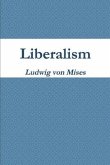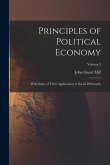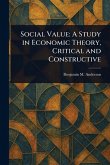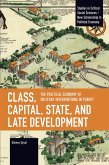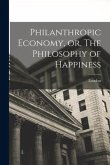Versandkostenfrei innerhalb Deutschlands
25,99 €
inkl. MwSt.
Versandkostenfrei*
Erscheint vorauss. 1. Juli 2026
Melden Sie sich
hier
hier
für den Produktalarm an, um über die Verfügbarkeit des Produkts informiert zu werden.

13 °P sammeln
- Broschiertes Buch
A succinct introduction to the theoretical debate on economic development and stagnation. In this book, André Nassif examines the complexity of economic theory, shaped by the interactions of diverse agents-firms, households, governments, and banks-across various markets. Despite its abstract nature, economic theories can be made accessible through careful explanation. Development and Stagnation covers the main theoretical foundations of economic development and incorporates key contributions from Latin America. Overall, the book offers a comprehensive overview of contemporary debates that…mehr
Andere Kunden interessierten sich auch für
![Liberalism Liberalism]() Ludwig von MisesLiberalism10,99 €
Ludwig von MisesLiberalism10,99 €![The Polish Transformation The Polish Transformation]() Grzegorz KonatThe Polish Transformation20,99 €
Grzegorz KonatThe Polish Transformation20,99 €![A Contribution to the Critique of Political Economy A Contribution to the Critique of Political Economy]() Karl MarxA Contribution to the Critique of Political Economy18,99 €
Karl MarxA Contribution to the Critique of Political Economy18,99 €![Principles of Political Economy: With Some of Their Applications to Social Philosophy; Volume 2 Principles of Political Economy: With Some of Their Applications to Social Philosophy; Volume 2]() John Stuart MillPrinciples of Political Economy: With Some of Their Applications to Social Philosophy; Volume 228,99 €
John Stuart MillPrinciples of Political Economy: With Some of Their Applications to Social Philosophy; Volume 228,99 €![Social Value Social Value]() Benjamin M Anderson (Benjamin McAleSocial Value20,99 €
Benjamin M Anderson (Benjamin McAleSocial Value20,99 €![Class, Capital, State, and Late Development Class, Capital, State, and Late Development]() Gönenç UysalClass, Capital, State, and Late Development25,99 €
Gönenç UysalClass, Capital, State, and Late Development25,99 €![Philanthropic Economy, or, The Philosophy of Happiness Philanthropic Economy, or, The Philosophy of Happiness]() (Margracia) LoudonPhilanthropic Economy, or, The Philosophy of Happiness23,99 €
(Margracia) LoudonPhilanthropic Economy, or, The Philosophy of Happiness23,99 €-
-
-
A succinct introduction to the theoretical debate on economic development and stagnation. In this book, André Nassif examines the complexity of economic theory, shaped by the interactions of diverse agents-firms, households, governments, and banks-across various markets. Despite its abstract nature, economic theories can be made accessible through careful explanation. Development and Stagnation covers the main theoretical foundations of economic development and incorporates key contributions from Latin America. Overall, the book offers a comprehensive overview of contemporary debates that critically engages with these theories while maintaining academic rigor.
Produktdetails
- Produktdetails
- Verlag: Haymarket Books
- Seitenzahl: 296
- Erscheinungstermin: 1. Juli 2026
- Englisch
- ISBN-13: 9798888908112
- Artikelnr.: 75282884
- Herstellerkennzeichnung
- Libri GmbH
- Europaallee 1
- 36244 Bad Hersfeld
- gpsr@libri.de
- Verlag: Haymarket Books
- Seitenzahl: 296
- Erscheinungstermin: 1. Juli 2026
- Englisch
- ISBN-13: 9798888908112
- Artikelnr.: 75282884
- Herstellerkennzeichnung
- Libri GmbH
- Europaallee 1
- 36244 Bad Hersfeld
- gpsr@libri.de
André Nassif is an Associate Professor at Fluminense Federal University, Brazil, specializing in Macroeconomics, Economic Development, and International Economics. A former BNDES economist, he has taught globally and published widely in academic journals and edited volumes.
Foreword
Luiz Carlos Bresser-Pereira
Preface
Figures and Tables
Introduction
Economic Development and Stagnation: the Different Theoretical Views
An Illustrative Case: Brazil from Economic Development to Stagnation
What to Expect from This Book
Organisation of the Book
Part 1: The Developmental School
Prologue to Part 1
1 The Conceptual Roots of Developmentalism
1 Introduction
2 Smith and Increasing Returns
3 Marx and Capital Accumulation
4 Schumpeter and Technological Progress as a Process of “Creative
Destruction”
5 Conclusion
2 Classical Developmentalism and Its Recent Unfoldings
1 Introduction
2 Economic Development as Structural Change: the Lewis Model with
Unlimited Labour Supply
3 The Big Push Model and Development as a Balanced Process
4 Production Linkages and Development as an Unbalanced Process
5 Industrialisation, Deindustrialisation and Stagnation
6 Conclusion
3 The Centre-Periphery Model and eclac’s Political Economy: Yesterday and
Today
1 Introduction
2 The Centre-Periphery Model as a Theoretical Basis for Latin American
Developmental Structuralism
3 eclac’s Political Economy and the Developmental State
4 eclac’s Neostructuralism and the Centre-Periphery Model Today
5 Conclusion
4 Underdevelopment, Development, and Stagnation: Celso Furtado’s
Theoretical Relevance
1 Introduction
2 Underdevelopment, Development and Stagnation under Furtado’s View
3 The Dutch Disease and the Resource Curse: Furtado’s Seminal Analysis
4 Conclusion
5 Prologue to New Developmentalism: Notes on the Inflation Targeting Regime
and Fiscal Austerity
1 Introduction
2 Inflation Targeting Regime
3 Fiscal Austerity
4 Conclusion
6 New Developmentalism: Integrating Macroeconomics with Development Theory
1 Introduction
2 The Central Theses of New Developmentalism
3 Critical Points of the New Developmental Theory
4 Conclusion
7 Conclusion and Policy Implications of Part 1: in Defence of the Return of
National Development Plans
Part 2: The Neoclassical Liberal School
Prologue to Part 2
8 International Trade Theories and the Case for Free Trade
1 Introduction
2 New International Trade Theories and the Reaffirmation of Free Trade
3 Conclusion
9 The Neoclassical Macroeconomics of Growth
1 Introduction
2 Growth Models in Closed Economies
3 Neoclassical Growth Models in Open Economies
4 Neoclassical Growth Models: the Developmental Critique
5 Conclusion
10 The Washington Consensus and the Ideology of Neoliberalism
1 Introduction
2 The Bretton Woods Era and Regulated Liberalism
3 The Washington Consensus and the Spread of Neoliberalism
4 Conclusion
11 Conclusion and Policy Implications of Part 2: Market Failures as a
Criterion for Adopting Public Policies
A Critical Evaluation of the Neoclassical Liberal Argument
1 Market Failures as a Criterion for Adopting Public Policies: the
Neoclassical Liberal Argument
2 Market Failures: a Critique of the Neoclassical Liberal Argument
Conclusion
Bibliography
Index
Luiz Carlos Bresser-Pereira
Preface
Figures and Tables
Introduction
Economic Development and Stagnation: the Different Theoretical Views
An Illustrative Case: Brazil from Economic Development to Stagnation
What to Expect from This Book
Organisation of the Book
Part 1: The Developmental School
Prologue to Part 1
1 The Conceptual Roots of Developmentalism
1 Introduction
2 Smith and Increasing Returns
3 Marx and Capital Accumulation
4 Schumpeter and Technological Progress as a Process of “Creative
Destruction”
5 Conclusion
2 Classical Developmentalism and Its Recent Unfoldings
1 Introduction
2 Economic Development as Structural Change: the Lewis Model with
Unlimited Labour Supply
3 The Big Push Model and Development as a Balanced Process
4 Production Linkages and Development as an Unbalanced Process
5 Industrialisation, Deindustrialisation and Stagnation
6 Conclusion
3 The Centre-Periphery Model and eclac’s Political Economy: Yesterday and
Today
1 Introduction
2 The Centre-Periphery Model as a Theoretical Basis for Latin American
Developmental Structuralism
3 eclac’s Political Economy and the Developmental State
4 eclac’s Neostructuralism and the Centre-Periphery Model Today
5 Conclusion
4 Underdevelopment, Development, and Stagnation: Celso Furtado’s
Theoretical Relevance
1 Introduction
2 Underdevelopment, Development and Stagnation under Furtado’s View
3 The Dutch Disease and the Resource Curse: Furtado’s Seminal Analysis
4 Conclusion
5 Prologue to New Developmentalism: Notes on the Inflation Targeting Regime
and Fiscal Austerity
1 Introduction
2 Inflation Targeting Regime
3 Fiscal Austerity
4 Conclusion
6 New Developmentalism: Integrating Macroeconomics with Development Theory
1 Introduction
2 The Central Theses of New Developmentalism
3 Critical Points of the New Developmental Theory
4 Conclusion
7 Conclusion and Policy Implications of Part 1: in Defence of the Return of
National Development Plans
Part 2: The Neoclassical Liberal School
Prologue to Part 2
8 International Trade Theories and the Case for Free Trade
1 Introduction
2 New International Trade Theories and the Reaffirmation of Free Trade
3 Conclusion
9 The Neoclassical Macroeconomics of Growth
1 Introduction
2 Growth Models in Closed Economies
3 Neoclassical Growth Models in Open Economies
4 Neoclassical Growth Models: the Developmental Critique
5 Conclusion
10 The Washington Consensus and the Ideology of Neoliberalism
1 Introduction
2 The Bretton Woods Era and Regulated Liberalism
3 The Washington Consensus and the Spread of Neoliberalism
4 Conclusion
11 Conclusion and Policy Implications of Part 2: Market Failures as a
Criterion for Adopting Public Policies
A Critical Evaluation of the Neoclassical Liberal Argument
1 Market Failures as a Criterion for Adopting Public Policies: the
Neoclassical Liberal Argument
2 Market Failures: a Critique of the Neoclassical Liberal Argument
Conclusion
Bibliography
Index
Foreword
Luiz Carlos Bresser-Pereira
Preface
Figures and Tables
Introduction
Economic Development and Stagnation: the Different Theoretical Views
An Illustrative Case: Brazil from Economic Development to Stagnation
What to Expect from This Book
Organisation of the Book
Part 1: The Developmental School
Prologue to Part 1
1 The Conceptual Roots of Developmentalism
1 Introduction
2 Smith and Increasing Returns
3 Marx and Capital Accumulation
4 Schumpeter and Technological Progress as a Process of “Creative
Destruction”
5 Conclusion
2 Classical Developmentalism and Its Recent Unfoldings
1 Introduction
2 Economic Development as Structural Change: the Lewis Model with
Unlimited Labour Supply
3 The Big Push Model and Development as a Balanced Process
4 Production Linkages and Development as an Unbalanced Process
5 Industrialisation, Deindustrialisation and Stagnation
6 Conclusion
3 The Centre-Periphery Model and eclac’s Political Economy: Yesterday and
Today
1 Introduction
2 The Centre-Periphery Model as a Theoretical Basis for Latin American
Developmental Structuralism
3 eclac’s Political Economy and the Developmental State
4 eclac’s Neostructuralism and the Centre-Periphery Model Today
5 Conclusion
4 Underdevelopment, Development, and Stagnation: Celso Furtado’s
Theoretical Relevance
1 Introduction
2 Underdevelopment, Development and Stagnation under Furtado’s View
3 The Dutch Disease and the Resource Curse: Furtado’s Seminal Analysis
4 Conclusion
5 Prologue to New Developmentalism: Notes on the Inflation Targeting Regime
and Fiscal Austerity
1 Introduction
2 Inflation Targeting Regime
3 Fiscal Austerity
4 Conclusion
6 New Developmentalism: Integrating Macroeconomics with Development Theory
1 Introduction
2 The Central Theses of New Developmentalism
3 Critical Points of the New Developmental Theory
4 Conclusion
7 Conclusion and Policy Implications of Part 1: in Defence of the Return of
National Development Plans
Part 2: The Neoclassical Liberal School
Prologue to Part 2
8 International Trade Theories and the Case for Free Trade
1 Introduction
2 New International Trade Theories and the Reaffirmation of Free Trade
3 Conclusion
9 The Neoclassical Macroeconomics of Growth
1 Introduction
2 Growth Models in Closed Economies
3 Neoclassical Growth Models in Open Economies
4 Neoclassical Growth Models: the Developmental Critique
5 Conclusion
10 The Washington Consensus and the Ideology of Neoliberalism
1 Introduction
2 The Bretton Woods Era and Regulated Liberalism
3 The Washington Consensus and the Spread of Neoliberalism
4 Conclusion
11 Conclusion and Policy Implications of Part 2: Market Failures as a
Criterion for Adopting Public Policies
A Critical Evaluation of the Neoclassical Liberal Argument
1 Market Failures as a Criterion for Adopting Public Policies: the
Neoclassical Liberal Argument
2 Market Failures: a Critique of the Neoclassical Liberal Argument
Conclusion
Bibliography
Index
Luiz Carlos Bresser-Pereira
Preface
Figures and Tables
Introduction
Economic Development and Stagnation: the Different Theoretical Views
An Illustrative Case: Brazil from Economic Development to Stagnation
What to Expect from This Book
Organisation of the Book
Part 1: The Developmental School
Prologue to Part 1
1 The Conceptual Roots of Developmentalism
1 Introduction
2 Smith and Increasing Returns
3 Marx and Capital Accumulation
4 Schumpeter and Technological Progress as a Process of “Creative
Destruction”
5 Conclusion
2 Classical Developmentalism and Its Recent Unfoldings
1 Introduction
2 Economic Development as Structural Change: the Lewis Model with
Unlimited Labour Supply
3 The Big Push Model and Development as a Balanced Process
4 Production Linkages and Development as an Unbalanced Process
5 Industrialisation, Deindustrialisation and Stagnation
6 Conclusion
3 The Centre-Periphery Model and eclac’s Political Economy: Yesterday and
Today
1 Introduction
2 The Centre-Periphery Model as a Theoretical Basis for Latin American
Developmental Structuralism
3 eclac’s Political Economy and the Developmental State
4 eclac’s Neostructuralism and the Centre-Periphery Model Today
5 Conclusion
4 Underdevelopment, Development, and Stagnation: Celso Furtado’s
Theoretical Relevance
1 Introduction
2 Underdevelopment, Development and Stagnation under Furtado’s View
3 The Dutch Disease and the Resource Curse: Furtado’s Seminal Analysis
4 Conclusion
5 Prologue to New Developmentalism: Notes on the Inflation Targeting Regime
and Fiscal Austerity
1 Introduction
2 Inflation Targeting Regime
3 Fiscal Austerity
4 Conclusion
6 New Developmentalism: Integrating Macroeconomics with Development Theory
1 Introduction
2 The Central Theses of New Developmentalism
3 Critical Points of the New Developmental Theory
4 Conclusion
7 Conclusion and Policy Implications of Part 1: in Defence of the Return of
National Development Plans
Part 2: The Neoclassical Liberal School
Prologue to Part 2
8 International Trade Theories and the Case for Free Trade
1 Introduction
2 New International Trade Theories and the Reaffirmation of Free Trade
3 Conclusion
9 The Neoclassical Macroeconomics of Growth
1 Introduction
2 Growth Models in Closed Economies
3 Neoclassical Growth Models in Open Economies
4 Neoclassical Growth Models: the Developmental Critique
5 Conclusion
10 The Washington Consensus and the Ideology of Neoliberalism
1 Introduction
2 The Bretton Woods Era and Regulated Liberalism
3 The Washington Consensus and the Spread of Neoliberalism
4 Conclusion
11 Conclusion and Policy Implications of Part 2: Market Failures as a
Criterion for Adopting Public Policies
A Critical Evaluation of the Neoclassical Liberal Argument
1 Market Failures as a Criterion for Adopting Public Policies: the
Neoclassical Liberal Argument
2 Market Failures: a Critique of the Neoclassical Liberal Argument
Conclusion
Bibliography
Index

